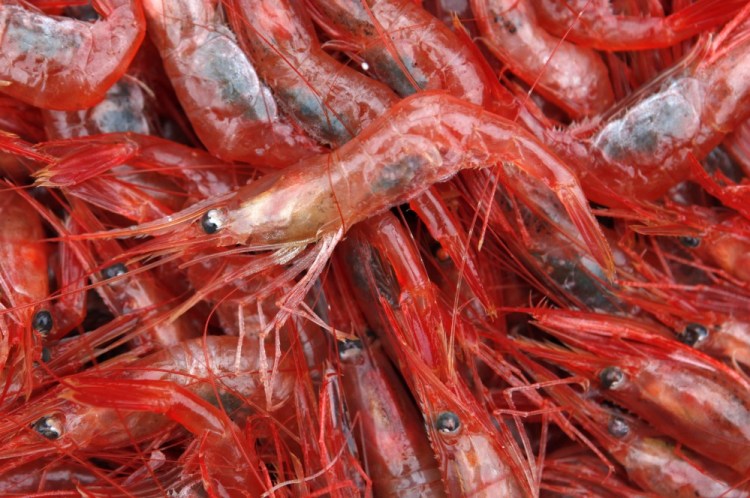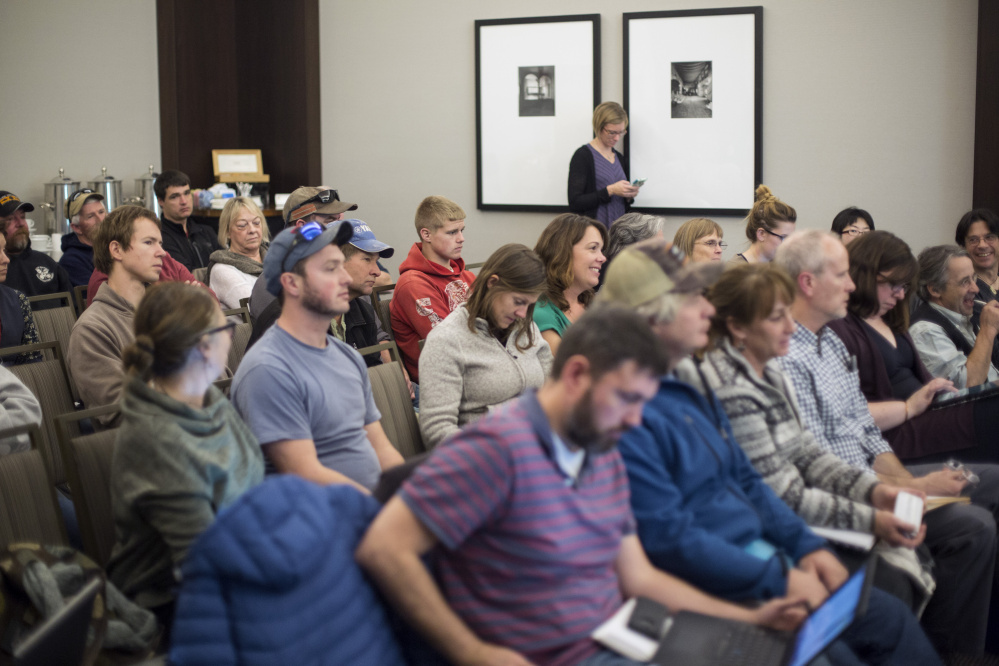Regional fisheries managers voted Wednesday to keep Maine’s commercial shrimp fishery closed for another year amid assessments showing record-low numbers of shrimp in the Gulf of Maine.
The northern shrimp section of the Atlantic States Marine Fisheries Commission opted to extend for a fifth year, through 2018, the moratorium on shrimp fishing in northern New England to allow depleted stocks to rebuild. Fishermen and Maine’s representatives on the shrimp panel had been pushing for a modest commercial fishery – ranging from 500 to 2,000 tons – but failed to convince their counterparts from Massachusetts and New Hampshire.
“After 40 years in this business, I know that Mother Nature has a remarkable ability, if we leave the spawning stock in the water, to recover,” said Mike Armstrong, the Massachusetts Division of Marine Fisheries representative to the panel. “I’m not convinced that is going to happen … but I want to give this stock a chance to recover for a few more years.”
The decision frustrated Commissioner Patrick Keliher of the Maine Department of Marine Resources, who responded by saying Maine would not participate in the planned 13.3-ton “research set-aside” fishery for shrimp.
“I am not sure we can ever recover the stock and I am personally at a point where I am ready to allow a small fishery to go forward while we continue to monitor the stock . . . to see what happens,” Keliher said.
SURVEY OF STOCKS NOT PROMISING
In 2010, Maine fishermen hauled in more than 12 million pounds of the small, sweet shrimp that have become a prized wintertime seafood for many New Englanders. But Maine’s shrimp fishery has been closed since an abbreviated 2013 season when extremely low catches created concerns about the health of the shrimp population.
The news hasn’t improved since then, based on summer surveys conducted by the fisheries commission and several research organizations.
The “total biomass” of northern shrimp in the Gulf of Maine and the number of spawning and harvest-size shrimp have been at record lows for the past six years. The commission’s scientific staff said Wednesday that survival of younger shrimp to add to the population – known as recruitment – has been “low to extremely poor” for seven consecutive years, and that the short-term prospects of the Gulf of Maine’s shrimp stocks were “very poor.”
Although research continues into the cause of the collapse, biologists believe that warming waters in the gulf are taking a toll on the temperature-sensitive shrimp. The gulf is the southern end of the shrimp species’ range, and a recent Gulf of Maine Research Institute study found that the gulf is warming faster than 99 percent of the world’s oceans.
“Long-term trends in environmental conditions have not been favorable for northern shrimp in the Gulf of Maine,” reads the commission staff’s recommendation on extending the moratorium on a commercial fishery. “This suggests a need to conserve spawning stock biomass to help compensate for what may continue to be an unfavorable environment.”
POPULATION STUDIES CHALLENGED
Fishermen attending Wednesday’s meetings at the Westin Portland Harborview Hotel did not dispute that shrimp are less abundant today than they were in years past. But they questioned the veracity and thoroughness of the commission’s shrimp population studies, saying they were not adequate to accurately assess what is happening with shrimp stocks.
Marshall Alexander, a fishermen from Biddeford who serves on the commission’s northern shrimp advisory panel, called the assessments “garbage” and “just a bunch of scribbling” on paper.
Another advisory panel member, Spencer Fuller of the lobster and shrimp processor Cozy Harbor Seafood in Portland, said regulators have “completely destroyed the markets and the processing facilities” in Maine by shutting down the fishery.
Instead, Fuller and other members of the advisory panel recommended a roughly two-month shrimp season beginning Jan. 21 with a 2,000-metric-ton quota. In Maine, which has historically accounted for the majority of the shrimp haul, state regulators could closely monitor the quota daily via electronic “swipe cards” that fishermen use to report their catch. That would allow a swift closure once the catch approaches the quota. But if the shrimp are nowhere to be found, as the commission’s assessment suggests, fishermen will soon discover that as well, fishermen said.
“The best way to approach it is the economic (model),” Fuller said after the meeting. “If the species is there, fishermen have proven the naysayers are wrong. And if they aren’t there, nobody is going to go out and fish.”
LET ‘ECONOMICS’ MANAGE SHRIMP FISHERY
Gary Libby, a Port Clyde fishermen who presented the advisory panel’s proposed 2,000-metric-ton season, said the commission should “let the economics manage the fishery.”
“The last three or four years, we’ve stayed home to build the stock and what we’ve got in return is the same thing,” Libby said of the fishery closures. “So as an industry we thought it was worth a risk to give us a small season to allow us to go out.”
Keliher, with the Maine Department of Marine Resources, backed a more modest 500-metric-ton season stretching from Feb. 21 to May 31 or until the quota is filled. Keliher described the compromise as a way to sustain a small, even boutique fishery that once was important to diversifying Maine’s commercial fisheries beyond lobster.
“What we’re wrestling with is a policy question of when do you fish on a stock that has been so impacted by environmental factors that, no matter what we do, we might not be able to restore it?” he said.
But Keliher’s two counterparts from Massachusetts and New Hampshire blocked the 500-ton proposal and, instead, voted to keep the fishery closed in 2018.
FACING THE SAME CHOICE FOR 2019?
The panel did approve a 13.3-metric-ton “research set-aside” that allows fishermen to catch and sell shrimp, with some of the proceeds supporting research projects. That is substantially less than the 53-metric-ton research set-aside authorized for 2017, and fishermen only managed to catch roughly 32 tons of shrimp.
Those “research set-asides” are the reason that consumers and restaurants have been able to purchase small amounts of northern shrimp from Maine in recent years. But an obviously frustrated Keliher told other panel members that his Maine department would not participate in the research set-aside program next year because the 13.3-ton quota was not large enough to justify the agency’s expenditures.
Panel chairman Dennis Abbott of New Hampshire said he hopes Keliher will reconsider and choose to participate in the set-aside program. He also predicted that, depending on next year’s numbers, the group could face the same choice for the 2019 season.
“Hopefully next year we are able to have some sort of a season where we see some rebound in the resource,” Abbott said. “Or, I think, next year we will be sitting back here … making a real difficult decision about whether we do as suggested and ‘roll the dice.’ ”
Kevin Miller can be contacted at 791-6312 or at:
Twitter: KevinMillerPPH
Send questions/comments to the editors.





Success. Please wait for the page to reload. If the page does not reload within 5 seconds, please refresh the page.
Enter your email and password to access comments.
Hi, to comment on stories you must . This profile is in addition to your subscription and website login.
Already have a commenting profile? .
Invalid username/password.
Please check your email to confirm and complete your registration.
Only subscribers are eligible to post comments. Please subscribe or login first for digital access. Here’s why.
Use the form below to reset your password. When you've submitted your account email, we will send an email with a reset code.